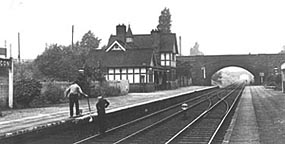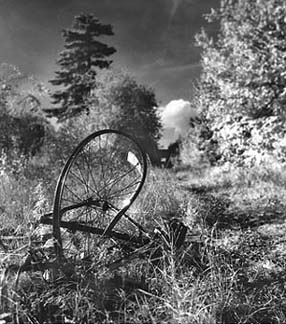|
 We
thought
you'd
like
to
see
this
interesting
photograph
of
the
old
Blacon
station
as
it
appeared
almost
50
years
ago
in
1951. The white line along the platform edge is being repainted using a long-handled
brush and a plank as a straight edge. We
thought
you'd
like
to
see
this
interesting
photograph
of
the
old
Blacon
station
as
it
appeared
almost
50
years
ago
in
1951. The white line along the platform edge is being repainted using a long-handled
brush and a plank as a straight edge.
The attractive station buildings are sadly
long gone, but the bridge survives unaltered.
This fascinating reminscience of the Blacon section of the old rail corridor by Terry Dodds appeared in the local press in August 2002:
"Changing the cycleway from one environment to another will no doubt please one and upset another. Yet the one thing you cannot take away is history.
I was born in Blacon in 1943. When I was a baby my mum would stand on Blacon station with my brothers and sister waiting for the big steam train to take us, pram and all, to town for the day.
The station master used to let the women and kids in his room when it was cold to sit by the big coal roaring fire. Half of Blacon's mums used the now defunct but then the only means of transport to Chester- Blacon corridor.
Great big puffing steam trains came up the hill from Sealand, shuddering to a halt, always full. The guard offloading the local fishmongers' fish.
I remember the kippers from Aberdeen and waiting for Alec Duncan to come in his van and distribute the fish to the Blacon people. There weren't many shops in Blacon there was a little shop on Highfield Bridge called Greenhaugh. It was kept by an old lady who served you with black mittens and a scarf to match.
Just across the road was the Highfield Hotel, kept by a respected landlord Reg Kite and his wife. Then of course you had a proper bar and a proper lounge where the ladies could socialise. There used to be a proper fair outside the pub. I had never seen a waltzer before.
As a kid I knew every house, and the name of the people in them as well. There were no locks, only latches. Just down the road from the pub was Rose Meade. They held the fete and all of Blacon got together and chipped in to crown Miss Blacon.
The coal merchant, Doreen Little, the post office's Jack Pring, Miss Loude the grocers all helped little business people, everyone knew everyone. There was no crime, no drugs, no boredom.
The Blacon corridor served the people well. I cycled down recently, but I wasn't prepared for the lesson in nostalgia that emerged.
I looked across to the dairy I used to go to at 5 am to catch the milk horse and help the milk man deliver the milk. I was a nipper, no more than eight or nine. The co-op man also delivered the bread by horse and cart.
A bit lower down and Blacon school emerged. Mr Williams, the headmaster, was respected by the people.
As I neared Egerton Bridge I looked up at the railway bank, it took me back to when I used to lie on the grass waiting for the train to pass and the train driver, old Norman Ellis, would take pity on us and throw some coal off the tender on to the railway lines. It smashed into little pieces and we would put the coal into a sack and take it home and sit around the fire listening to Journey into Space, or if we were really treated, the Wednesday evening play on the radio.
Carrying on through, I passed Hallidays farm. He pasteurised his own milk and cooled it, bottled it with cardboard topping and delivered it at 5am with a whistle. I know I sat on the back of his Morris 8 (or something) helping him.
A little lower took me to Wash Hall Farm. Old Ma Shaw and Tony Darcy woutd chop the trees for logs to be put on tbe horse and cart and sold house to house.
I saw the village hall, now a video shop, it used to hold whist drives on Tuesday and Bob Edwards had a rock 'n' roll night on a Friday. He took his radiogram, then a luxury, to act as a disco.
The only church backed on to the railway bank. All tbe kids went to Sunday school. After the vicar Mr Wright had finished with us we used to go home via the bottom of the church garden and down to the railway bank, birds' egging, then cut across the camp home.
The camp, Blacon Camp as it is now called, was part of the community. I remember the soldiers used to have Laurel and Hardy films shown in tbe gym for the families.
The cook house was run by ATS women who would hand out hot cakes to us. There was a German prisoner of war we called Choker. He said, 'Come here, if you don't I'll choke you', and we would run home.
There used to be square bashing on a Sunday morning on the parade ground. All you could hear was hundreds of boots marching and the NCO Sgt Dodsworth bellowing out his orders.
There was a golf course in Blacon, by Gorsts Hill. It's not called Gorse Hill, as christened by the newspapers. There was a family called the Gorsts, who lived on the hill at Clifton Drive. They were a family of farmers, again well respected.
On the way home along the corridor I could see Smiths Corner, where all the posh people lived. In fact many still do.
Yes, Blacon was the place to live. The corridor, as it's now called, used to heave with people. Full employment carried the fellas to the steelworks- three shifts, 10 trains one way. People walked to Chester down the lines and went up the Liverpool Road train station to town.
The canal was our bathing pool. The corridor gave- it still does, no matter what you do with it.
Just remember its history, and treat it with respect. I do, and so do quite a few other Blacon people".
|
 Approximately
the
same
location
as
the
last
photograph-
the
site
of
the
former
Blacon
railway
station
near
to
Church
Hall
Close-
but
looking
towards
the
bridge
that
carries
Saughall
Road
over
the
line.
Durham
Road
continues
on
our
right.
Approximately
the
same
location
as
the
last
photograph-
the
site
of
the
former
Blacon
railway
station
near
to
Church
Hall
Close-
but
looking
towards
the
bridge
that
carries
Saughall
Road
over
the
line.
Durham
Road
continues
on
our
right.
 We
thought
you'd
like
to
see
this
interesting
photograph
of
the
old
Blacon
station
as
it
appeared
almost
50
years
ago
in
1951. The white line along the platform edge is being repainted using a long-handled
brush and a plank as a straight edge.
We
thought
you'd
like
to
see
this
interesting
photograph
of
the
old
Blacon
station
as
it
appeared
almost
50
years
ago
in
1951. The white line along the platform edge is being repainted using a long-handled
brush and a plank as a straight edge.